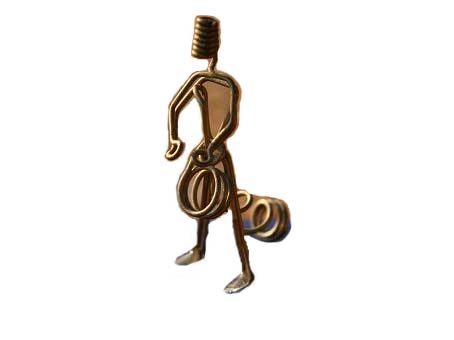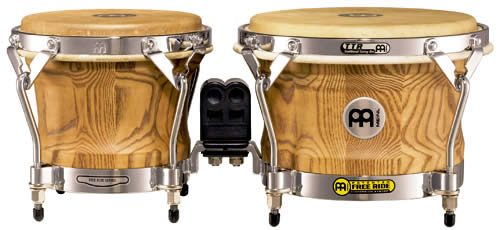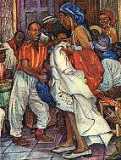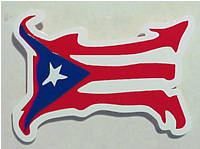Tunning Bongos
13 posts
• Page 1 of 1
What Ray said, plus it matters on genre and band and tune.
Each could depict how they should be tuned. Listen to some
of your favorite tunes and go from there.
Then as you progess in performance, you will start to learn where you like them tuned at.
T
Each could depict how they should be tuned. Listen to some
of your favorite tunes and go from there.
Then as you progess in performance, you will start to learn where you like them tuned at.
T
-

Tonio - Posts: 1209
- Joined: Sat Aug 30, 2003 1:59 am
- Location: San Diego
Hi guys!
I would like to know one more thing about tuning bongos and congas together...
Many times I play quinto+conga+bongos which i tune classically (conga+quinto=here comes the bride... and bongos octave apart) but tell me what is your interval between quinto and hembra or conga and hembra?
I am a partial music literate, but sometimes I experiment and tune them a bit or a lot apart (congas vs. bongos) and it's very exiting, but what is your ''smashing'' interval?
Thanks,
Primozz
Thanks
I would like to know one more thing about tuning bongos and congas together...
Many times I play quinto+conga+bongos which i tune classically (conga+quinto=here comes the bride... and bongos octave apart) but tell me what is your interval between quinto and hembra or conga and hembra?
I am a partial music literate, but sometimes I experiment and tune them a bit or a lot apart (congas vs. bongos) and it's very exiting, but what is your ''smashing'' interval?
Thanks,
Primozz
Thanks
It's about liberating yourself, man!!!
http://www.myspace.com/odfranclnamozgani
http://www.myspace.com/perkakns
http://www.myspace.com/strojmachine
http://www.myspace.com/robertjerele
http://www.myspace.com/odfranclnamozgani
http://www.myspace.com/perkakns
http://www.myspace.com/strojmachine
http://www.myspace.com/robertjerele
-

GuruPimpi - Posts: 487
- Joined: Thu Dec 09, 2004 2:12 am
- Location: Slovenija
GuruPimpi,
Bongos you are right...Octave is the standard...I tune my bongos by making sure that the "baqueteo" or "caballito" pattern on the bongos sounds nice and crisp. And the accents need to "pop". I'm a fan of higher "macho" head tuning. Whatever you get the macho to, bring the hembra up to the same tone, just an octave lower
Congas.
Two congas, I usually make the distinction of about 4th (SOL on Tumbadora to DO on Quinto). Think of the tone used in Timpani performances, like (Bim, Bom, Bim, Bom, Bim, Bom, BIIIIMMMMMM). Now keep that tone in mind, and tune the congas to the same distance. It's a SOL-DO distinction. How do you know how high the "Do" is going to be? Again, make sure that the baqueteo/tumbao pattern is nice, audible, and crisp, and that the tension is night and tight on the Quinto. Make sure you can get easy muted, open, slap, open slap, and open SNAP tones. Whatever you get on the Quinto, tune the Tumbadora to the SOL under it.
For three congas, I play around. It can be 4th differentials, or it can be tuned in thirds. Do, Mi, Sol
This time around, instead of starting with a Do pitch on the Quinto and then setting the Sol on Tumbadora 4 pitches lower from the Do on the quinto, I actually start with the Tumba.
Set the Do on the tumba, raise the Conga to the Mi (2 pitches higher) and the Quinto to Sol (2 pitches higher than Conga).
If you do that, you will be able to get Do Mi Sol, and play down from the quinto, Sol-Mi-Do. You can do some really creative variations with that.
4 congas - With Requinto drum added. Use the setup of thirds with 3 congas (Do - Tumba, Mi - Conga, Sol - Quinto) and make the Requinto be SI. Think of the scale, Do Re Mi Fa Sol La Si Do, without any flats or sharps. Now, flat the Si.
Do Mi Sol Si (flat). It sounds like a scale from an ending to a jazz song. It doesn't matter what actual note you use as the "Do"...just make sure you make the Mi, Sol, and Si-flat conform to the standard major scale of that note.
Example, Assume Do (Tumba) is C, make Conga - E, make Quinto G, and Requinto - Bb (in a standard scale from C, B natural would be the normal "si", but you're flattening it).
With that tuning, you can have interesting variations with the standard 3 conga setup, and add the Bb here and there (the requinto isn't used much in regular beats, except to add color here and there). Alternatively, you could make the Requinto just be an Octave higher from the Tumba (higher Do), but, personally, I like to have 4 different tones, to really give the beats some creative tones...if are going up a scale, you could always play, Do, Mi, Sol, Si-flat, and hit the Tumba again, Do, so you wouldn't have to waste the Requinto on a higher Do.
Giovanni Hidalgo, on his Virtuoso video, seemed to have another three conga tone setup. I believe it was, Do on the Tumba, Mi-FLAT on the conga, Fa on the Quinto. Imagine on a C scale, C on Tumba, Eb on Conga, F on Quinto. Try that one as well, and imagine what tone would be cool to add to the Requinto above the Quinto. Try that variation of tones as well.
Hope that tuning ideas helps.
Edited By Firebrand on 1115410914
Bongos you are right...Octave is the standard...I tune my bongos by making sure that the "baqueteo" or "caballito" pattern on the bongos sounds nice and crisp. And the accents need to "pop". I'm a fan of higher "macho" head tuning. Whatever you get the macho to, bring the hembra up to the same tone, just an octave lower
Congas.
Two congas, I usually make the distinction of about 4th (SOL on Tumbadora to DO on Quinto). Think of the tone used in Timpani performances, like (Bim, Bom, Bim, Bom, Bim, Bom, BIIIIMMMMMM). Now keep that tone in mind, and tune the congas to the same distance. It's a SOL-DO distinction. How do you know how high the "Do" is going to be? Again, make sure that the baqueteo/tumbao pattern is nice, audible, and crisp, and that the tension is night and tight on the Quinto. Make sure you can get easy muted, open, slap, open slap, and open SNAP tones. Whatever you get on the Quinto, tune the Tumbadora to the SOL under it.
For three congas, I play around. It can be 4th differentials, or it can be tuned in thirds. Do, Mi, Sol
This time around, instead of starting with a Do pitch on the Quinto and then setting the Sol on Tumbadora 4 pitches lower from the Do on the quinto, I actually start with the Tumba.
Set the Do on the tumba, raise the Conga to the Mi (2 pitches higher) and the Quinto to Sol (2 pitches higher than Conga).
If you do that, you will be able to get Do Mi Sol, and play down from the quinto, Sol-Mi-Do. You can do some really creative variations with that.
4 congas - With Requinto drum added. Use the setup of thirds with 3 congas (Do - Tumba, Mi - Conga, Sol - Quinto) and make the Requinto be SI. Think of the scale, Do Re Mi Fa Sol La Si Do, without any flats or sharps. Now, flat the Si.
Do Mi Sol Si (flat). It sounds like a scale from an ending to a jazz song. It doesn't matter what actual note you use as the "Do"...just make sure you make the Mi, Sol, and Si-flat conform to the standard major scale of that note.
Example, Assume Do (Tumba) is C, make Conga - E, make Quinto G, and Requinto - Bb (in a standard scale from C, B natural would be the normal "si", but you're flattening it).
With that tuning, you can have interesting variations with the standard 3 conga setup, and add the Bb here and there (the requinto isn't used much in regular beats, except to add color here and there). Alternatively, you could make the Requinto just be an Octave higher from the Tumba (higher Do), but, personally, I like to have 4 different tones, to really give the beats some creative tones...if are going up a scale, you could always play, Do, Mi, Sol, Si-flat, and hit the Tumba again, Do, so you wouldn't have to waste the Requinto on a higher Do.
Giovanni Hidalgo, on his Virtuoso video, seemed to have another three conga tone setup. I believe it was, Do on the Tumba, Mi-FLAT on the conga, Fa on the Quinto. Imagine on a C scale, C on Tumba, Eb on Conga, F on Quinto. Try that one as well, and imagine what tone would be cool to add to the Requinto above the Quinto. Try that variation of tones as well.
Hope that tuning ideas helps.
Edited By Firebrand on 1115410914
- Firebrand
- Posts: 293
- Joined: Sun Jun 13, 2004 11:26 pm
- Location: Western Massachusetts
Firebrand!
Thank You very much for very understandeable and clear tuning conga words, I will sure use the ideas...
But, what about bongos and congas (2 or 3) together, what is your interval between them? Same like with tumba&conga+quinto(hembra?)&requinto(macho?)?
I can try that... Me too like the macho being high and crispy
Primozz
Thank You very much for very understandeable and clear tuning conga words, I will sure use the ideas...
But, what about bongos and congas (2 or 3) together, what is your interval between them? Same like with tumba&conga+quinto(hembra?)&requinto(macho?)?
I can try that... Me too like the macho being high and crispy
Primozz
It's about liberating yourself, man!!!
http://www.myspace.com/odfranclnamozgani
http://www.myspace.com/perkakns
http://www.myspace.com/strojmachine
http://www.myspace.com/robertjerele
http://www.myspace.com/odfranclnamozgani
http://www.myspace.com/perkakns
http://www.myspace.com/strojmachine
http://www.myspace.com/robertjerele
-

GuruPimpi - Posts: 487
- Joined: Thu Dec 09, 2004 2:12 am
- Location: Slovenija
Please, do not shout (use lower case instead of all capital letters)...
In physics, an octave above is double frequency and an octave below is half the frequency... (if you do not know what frequency means I hope you find it out)
In music, an octave means... I do not know correct English terms so I say just that octave is, for example in note scale, a tune from C1-to-C2.
In practise, an octave means that if you hit simultaneously two notes that are an octave apart they do not interfer each other.
In Bongo... I want also to know why macho and hembra should be an octave apart... Bongo base frequency is not so clear due macho sound has lots of frequencies, and macho tick is so short that it should not disturb hembra much...
So... I think, I need your feedback about this issue too...
In physics, an octave above is double frequency and an octave below is half the frequency... (if you do not know what frequency means I hope you find it out)
In music, an octave means... I do not know correct English terms so I say just that octave is, for example in note scale, a tune from C1-to-C2.
In practise, an octave means that if you hit simultaneously two notes that are an octave apart they do not interfer each other.
In Bongo... I want also to know why macho and hembra should be an octave apart... Bongo base frequency is not so clear due macho sound has lots of frequencies, and macho tick is so short that it should not disturb hembra much...
So... I think, I need your feedback about this issue too...
- arpa
- Posts: 18
- Joined: Fri Sep 09, 2005 5:16 pm
- Location: Finland
One thing that wasn't mentioned which IMHO is massively important is to always tune down after playing.
I've heard with fibreskyns u dont really need to but I havent used them b4 so cant speak on experience. I have however ordered some for my new Meinls so I'll see but just to be safe I would always de-tune.
Also, when tuning up u should always go across, half a turn at a time. Check out http://www.bongomania.com to see pictures etc.
Those of u that have David Romero's dvd will also know what I mean. I think u get the best results by tuning the bongos this way and believe me I've tried every method u can think of!
Que siga la rumba!
Mikee
I've heard with fibreskyns u dont really need to but I havent used them b4 so cant speak on experience. I have however ordered some for my new Meinls so I'll see but just to be safe I would always de-tune.
Also, when tuning up u should always go across, half a turn at a time. Check out http://www.bongomania.com to see pictures etc.
Those of u that have David Romero's dvd will also know what I mean. I think u get the best results by tuning the bongos this way and believe me I've tried every method u can think of!
Que siga la rumba!
Mikee
Mikee
London UK
London UK
-

bongomikee - Posts: 19
- Joined: Thu Sep 29, 2005 1:27 pm
- Location: London UK
BongoMikee, I have been using fyberskin for some time now. In my wooden bongó I always release the preassure a little because too much preassure on the wood for a long period of time may produce a crack,on the other fiberglass Bongó I never detune but I found that every time I play I have to tune up to get the sound I like. That means to me that even though they are synthetic skins they tend to expand a little and loose their tone. Remember to put some good quality lubricant on your tunning lugs that will make them last forever. Pa' encima Rumbero
Josean
-

caballoballo - Posts: 1043
- Joined: Thu Sep 01, 2005 10:28 pm
- Location: Rio Grande Puerto Rico
Alafia Caballoballo!
Espero que todo este bien contigo mi pana!
You know a few years ago, un tipo me dio una cabeza de Fyberskin para el macho de mi bongoces. Well, I mounted it, and #### if that sound wasn't crisp and clean! I thought that I had died and gone to bongo heaven :laugh: Well about three weeks after that, I seem to have forgotten that I live out here in the hot desert of Phoenix, the head ripped right at the seam. I was quite dissapointed with myself for not paying more attention to it. I didn't tune them down, like with natural hide heads, I just assumed, como bobo, that I could tune them and forget about them.
Since then however, I have put some NuSkyn heads on them and I've grown accustomed to the sound. Maybe that's a good thing, or maybe not! I guess in time I'll notice the difference more acutely. I do agree however that the sound is "less" crisp than the Fyberskin heads!
Sacude ese zapato viejo mi hermano!
Onile!
Edited By onile on 1128028015
Espero que todo este bien contigo mi pana!
You know a few years ago, un tipo me dio una cabeza de Fyberskin para el macho de mi bongoces. Well, I mounted it, and #### if that sound wasn't crisp and clean! I thought that I had died and gone to bongo heaven :laugh: Well about three weeks after that, I seem to have forgotten that I live out here in the hot desert of Phoenix, the head ripped right at the seam. I was quite dissapointed with myself for not paying more attention to it. I didn't tune them down, like with natural hide heads, I just assumed, como bobo, that I could tune them and forget about them.
Since then however, I have put some NuSkyn heads on them and I've grown accustomed to the sound. Maybe that's a good thing, or maybe not! I guess in time I'll notice the difference more acutely. I do agree however that the sound is "less" crisp than the Fyberskin heads!
Sacude ese zapato viejo mi hermano!
Onile!
Edited By onile on 1128028015
Que Nsambi les acutare pa' siempre!
-

onile - Posts: 1259
- Joined: Sun Sep 11, 2005 5:23 pm
- Location: USA
Hi Caba,
Yeah I would always de-tune regardless just to be on the safe side.
Yeah I have some lubricant so I'll be sure to use it. Thanks amigo!
Edited By bongomikee on 1128083008
Yeah I would always de-tune regardless just to be on the safe side.
Yeah I have some lubricant so I'll be sure to use it. Thanks amigo!
Edited By bongomikee on 1128083008
Mikee
London UK
London UK
-

bongomikee - Posts: 19
- Joined: Thu Sep 29, 2005 1:27 pm
- Location: London UK
13 posts
• Page 1 of 1
Who is online
Users browsing this forum: Google Adsense [Bot] and 42 guests